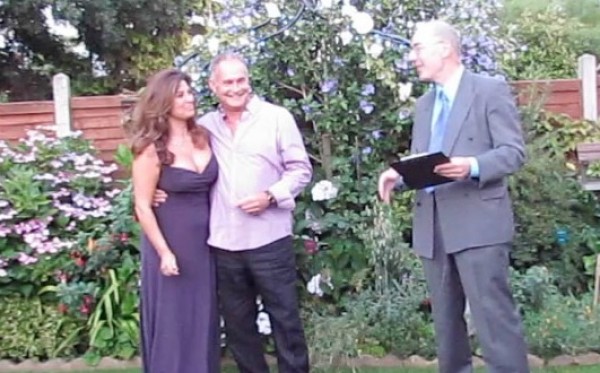by Michael | Dec 16, 2014 | Blog
It’s time for something a bit more cheerful after my last two blogs (concerning death!). Why not a seasonal outdoor ceremony?
Hold your horses (or reindeer?), I hear you say. Who’d have a wedding or vow renewal in the open – in the deep midwinter?
Source: charlottesweddings.com
Well, I agree that it’s a huge gamble. Nobody relishes a wet, cold ceremony. But just imagine if you get one of those crisp, snowy days, with a blue sky. What could be more magical?
If you’re thinking of going for it, there are some ways of harnessing the climate to your advantage; you can also lessen its (negative) impact. So here’s what I suggest.
The Weather
If you’ve taken the plunge (sorry about the pun!), then accept that you’ve taken a decision and you have to make the best of it.
Two nice touches you could adopt are:
- Issue blankets (whether in themed colours or not) to guests
- When the guests arrive at the reception, rather than ice-cold champagne, why not offer them hot chocolate or mulled wine?
Source: www.weddingbee.com
Make the Weather your Theme
You can use snowy scenes as background for your wedding invitations, RSVP cards, and, on the day, for the place cards.
Table decoration could include pine cones, foliage and lots of white. If it is likely to be snowy weather, plain white can work very well for the colour scheme.
You might even replace flowers (which, being out of season locally, can be costly) with pine cone bouquets, which are attractive as well as rather original.
Candles or tea lights may be a good idea, but you will have to take good old health and safety into account – people need to be able to see where they’re going and you don’t want fires breaking out, either! Also bear in mind that exposure to the elements may cause candles to be blown out or even to fall over!
Seasonal Colour
If you are having white as your themed colour, this may allow you to choose strong colours for bridesmaids, which could look very striking.
You can style the wedding cake with festive red and white.
The Garden
It can be a lot cheaper to use your garden for the wedding, rather than hiring a venue, and it may have, well, a homely feel about it, which can be charming. However, you could save less money than you think, and you risk missing out on that valuable peace of mind that dealing with professionals should afford.
You’ll have to make suitable arrangements for tables, chairs, toilets, parking, catering, place settings and electricity. Then you will need to offer protection from the elements, possibly providing blankets, as already suggested, and even umbrellas.
So, yes, an outdoor winter ceremony is a dangerous gamble, but the rewards can be so worthwhile …!
Michael Gordon can help prepare and conduct a tailor-made civil ceremony in or around London, or, indeed, in Europe.

by Michael | Dec 2, 2014 | Blog
Let’s be brutally frank: it’s funeral season.
I don’t have any celebration ceremony bookings at present until early Spring, but currently there is no shortage of requests for me to create and conduct funerals. This may well increase as the weather (presumably) worsens.
So, rather than give guidance, as I usually do, about weddings and vow renewals, etc., I thought I’d offer some musings about less happy events. And, let’s face it, we’re all going to die some time ..
Death
If someone dies at home (or in a nursing home), a doctor must be called to issue the Medical Certificate of Death. This will be done by hospital staff, if the deceased dies while in hospital.
Assuming there is no need for a post-mortem, etc., the next step, before arranging the funeral, is to make an appointment to see the Registrar.
Registering the Death
There are lots of choices how to commemorate a death, but, come what may, it has to be recorded legally. So the registrar will need to be informed, and will want:
- details of the death (including the Death Certificate)
- name, address, date and place of birth of the deceased
- their occupation
- whether they were receiving a pension or allowance from public funds
- if married, the date of birth of the surviving spouse.
The funeral
The Procession
Historically, a cortege was much favoured, and today you can still see horse-drawn hearses. Most commonly, though, it will be a limousine – although you can actually come across a range of creative ideas for the procession (eg motorcycle hearses, or bringing the coffin by a lorry, say, to reflect the deceased’s profession or passion).

Burial
There are a number of interesting customs still in use – mostly in Wales, Scotland and Northern Ireland, where burial tends to happen sooner. Some regional traditions include the use of cords to lower the coffin (Scotland), families in Wales announce a death by pinning cards to lamp posts and there are the ‘lifts’ (Northern Ireland), where the coffin is passed from hand to hand. In England, rosemary may be placed on the coffin or at the graveside (symbolising remembrance).
It is traditional to strew soil or rose petals over the coffin, but nowadays there are new rituals, which may include live music, fireworks, release of doves, bubbles or balloons.

Cremation
Ashes can be buried, scattered or kept, so it is as well to consider these options carefully. There are various regulations about scattering or burying ashes, and a Funeral Director should be able to advise you.
The service
Music still plays a big part at a funeral, but religious music is in decline. People prefer songs associated with the deceased (or chosen by them). An organ is often an option, but usually the chapel may have a Wesley System (which can access most songs). Alternatively or additionally, CDs or MP3s are the order of the day.
Orders of service have often become more elaborate than they once were. Now, in addition to the deceased’s name, date of birth and death and the words of any hymns being sung, there may well be photographs and stories.
Speeches and Eulogies
In many cases, the person leading the service still delivers the eulogy, but increasingly family, friends and work colleagues may contribute a poem, a memory or a tribute.
In my next blog, I intend to pick up from here and give some tips about writing an eulogy (tips, incidentally, which may hold good for speech-writing for more cheerful occasions).
Michael Gordon can help prepare and conduct a tailor-made civil ceremony in or around London or, indeed, in Europe.

by Michael | Sep 23, 2014 | Blog
Following on from my last blog – why you should consider a vow renewal – I’d like to look at how you can save money once you’ve decided to go for the vow renewal.
The good news about vow renewals is that they tend to be a lot cheaper than weddings! However, nobody wants to spend more than they need to, so here are some suggestions that can lighten the load.
Venue
If you opt for a building or place of worship, you’ll find you’re in competition with people looking for a wedding venue. That means that the need to book early – and prices – will reflect the demand. What about holding the ceremony in your garden – assuming you have one, of course? It will take some time and effort to clean it up and prepare it, and a little imagination and expense to decorate it, but it could work very well. (Remember to warn the neighbours, though!)
You might be able to hold your ceremony in a public place like a park – but you may still need permission from the landowner (and there may well be a charge).

Clothing
If you still have the clothes you were married in, why not wheel them out again? You may have changed shape a bit in the intervening years, so do try them on well beforehand. A tailor’s alterations may save you a lot compared to buying a new outfit.
If you do want to buy from new, you may be able to find suitable attire at a good price online or wait for sales’ season.
There’s nothing to stop you from having a casual affair, so you can use clothes already in your wardrobe.
You could always compromise by buying a couple of items – shoes for her, and a tie for him, say.
Photographer
I always advocate a professional photographer for a wedding, and the same applies for a vow renewal. However, you can often get a cheaper rate, if you find a photographer just starting out. You might be able to enquire from a nearby college whether there are any photography students that they could recommend for you.
You can advertise, of course, although this can add quite a bit to your costs. Craigslist is seen by many photographers.
Food
There’s much to be said for professional caterers, but they do add a lot on to the price. A sit-down meal is complex as well as dear, but, provided you have places to sit, a buffet will work really well. If preparing it yourself, you could ask family and friends to bring a dish. You might be able to buy from wholesale cash and carries, if you’re buying in bulk, and save money that way.
Note that fruit and vegetables that are in season are likely to be cheaper.
Final thought
I haven’t mentioned the civil celebrant, but their ceremonies usually cost a lot less than weddings.
Using this advice, you should be able to plan a lovely ceremony without too much work or expense. As you would with a wedding, make sure you and your partner are in agreement about all the arrangements!
Enjoy!
Michael Gordon can help prepare and conduct a tailor-made civil ceremony in or around London or, indeed, in Europe.
by Michael | Jul 15, 2014 | Blog
They say that working with children is one of the riskiest things performers can do, as you can never predict children’s behaviour.
The same thing applies to formal ceremonies – weddings, vow renewals, etc.
One option is to make the event child-free, which is absolutely fine, so long as you make this clear on the invitations.
However, not everybody wants – or is able – to do this. So how can you reduce the risk of your ceremony being taken over by over-tired little Orville or attention-seeking Annette?
Here are some ideas.
If you can give them jobs – and show due appreciation afterwards – they will feel valued and will aim to please.
Possible jobs
At the ceremony
Children aged between 4 and 8 or so can serve as flower girls (or boys). One tip here is to make sure that their clothes are comfortable, so they do not become fidgety and, indeed, grumpy.
Older children (between, say, 8 and 14) can be pages or ladies-in-waiting. They may do errands (such as fetching a glass of water or passing messages) and will enjoy the responsibility.
Gift-attendants will suit 12-14-year-olds (assuming the event is big enough for this to be relevant). The children can simply watch over the gifts or possibly tag them with the name of the giver.
You may want a guest-book attendant. Provided that the child is reasonably outgoing, he or she can invite all the guests to sign the guest book. This will probably suit a friendly child over the age of about 14.
Ushers are always useful. Older children may do this best, but they can even have a little train of young ushers to look after. It’s nice if the youngsters can take adult guests by the hand and lead them to their seat!
At the Reception
Food and Drink
Work with the caterer to ensure there is kid-friendly fare out there. I’m personally all for a healthy diet, but on the odd occasion I think we can turn a blind eye. So bring on the chips, mini-burgers, cheese pies, spaghetti hoops, jam or peanut butter sandwiches, Pringles and the like! Provide juice (and if you serve it in goblet-like cups, the children can join in the toasting) and also still water.
Activities
Colouring books, sticker books, box decorating, fabric painting are usually popular with children. If you have a separate room for them, then they might be able to watch a video or even play games like bingo or musical chairs. They may need activity directors to organize these activities (pre-teens are often excellent at this).
Bubble-blowing is another popular option.
Finally, don’t forget to offer, if you can, a chill-out space.
Of course, you may be able to enlist the help of a parent or adult friend to supervise what goes on, or hire an entertainer such as a magician, but you might be surprised how successfully youngsters may run the show. And they come somewhat cheaper!
At any rate, the children will appreciate that they have been included in the adults’ celebration in such a way that they can feel useful and really enjoy themselves, and their behaviour should reflect this.
So everyone’s a winner!
Michael Gordon can help prepare and conduct a tailor-made civil ceremony in or around London or, indeed, in Europe.
by Michael | Jun 18, 2014 | Blog
The Summer Solstice is almost upon us (depending when you read this!). It’s a fantastic time for handfastings. “For what?” I hear some of you say.
Allow me to elaborate.
If you don’t know, I shall assume that you are not a Druid or pagan, and if you are, please understand that I am writing this for the uninitiated. There are, however, different kinds of handfastings, so there’s no single answer to the question.
Example of a handfasting
Remember when Kate and Prince William got married? Although it was a religious C of E ceremony, there was an element of handfasting in there when the couple took each other’s hands, and they were covered by a ribbon.
It was a lovely simple ritual.
Now if you take that one step further and bind the two hands together, you have a handfasting.
Incidentally, this gives rise to the expression “tying the knot” and also “bonds of holy matrimony”.
Origins
This ceremony probably originated in Celtic times; however, it flourished in Europe until the mid 1700s. Up till then, few unions were sanctified in a religious building like a church. Rather, they were celebrated by a simple handfasting ceremony in which the two partners joined hands over the village anvil, in the fields or in the groves of trees. Today, we build upon this tradition.
The basics
The couple link and cross hands (normally right hand to right, and left to left) to form an infinity circle, symbolising the entirety of the universe as represented in their relationship. Then, with a cord or ribbon (or ribbons), the wrists are tied and knotted, in a lovers’ knot, to the accompaniment of a suitable text, to symbolise the joining together of the two people in lives and spirits.
The cords are then removed, normally by the couple – occasionally, with difficulty! – with the knots still in place. They will take the cord away with them and, ideally, it will remind them of their vows, should they hit a rocky patch.
Where does this happen?
Again, it depends, but many people prefer a quiet, open-air historic site that may be considered to be spiritual and preferably pagan – such as standing stones.
What about Stonehenge?
A civil celebrant, such as myself, can conduct a handfasting wedding or vow renewal in the Inner Circle at Stonehenge (normally around dawn or dusk), but this needs to be booked months in advance (and the Druids will have priority at the solstice). However, places like Avebury, Old Sarum or the Rollright Stones might do very well.
it’s a little late for this Summer, but do have a chat (020 8866 4326) and see if we can sort something very special out for you!
Michael Gordon can help prepare and conduct a tailor-made civil ceremony (including a handfasting) in or around London or, indeed, in Europe.



